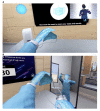The Comparative Effectiveness of Virtual Reality Versus E-Module on the Training of Donning and Doffing Personal Protective Equipment: A Randomized, Simulation-Based Educational Study
- PMID: 35510011
- PMCID: PMC9060736
- DOI: 10.7759/cureus.23655
The Comparative Effectiveness of Virtual Reality Versus E-Module on the Training of Donning and Doffing Personal Protective Equipment: A Randomized, Simulation-Based Educational Study
Abstract
Introduction Preventing errors in donning and doffing of personal protective equipment (PPE) is critical for limiting the spread of infectious diseases. Virtual reality (VR) has demonstrated itself as an effective tool for asynchronous learning, but its use in PPE training has not been tested. The objective of this study was to compare donning and doffing performance between VR and e-module PPE training. Methods A prospective randomized open-blinded controlled trial was conducted to determine differences in donning and doffing performance after VR and e-module PPE training among medical staff and medical students at a single institution. The primary outcome was donning and doffing performance with real PPE, assessed using a 64-point checklist. The secondary outcome was participant preparedness and confidence level after training. Results Fifty-four participants were randomized, mostly consisting of medical students (n=24 {44%}) or emergency medicine and otolaryngology residents (n=19 {35%}). The VR group (n=27 {50%}) performed better than the control in the overall PPE scores but this was not statistically significant (mean {SD}, VR: 55.4 {4.4} vs e-module: 53.3 {8.1}; p = 0.40). VR participants also reported higher levels of preparedness and confidence after training. Residents as a subgroup achieved the highest increases after VR training compared to their counterparts in the control training group (mean {SD}, VR: 55.6 {4.9} vs e-module 48.4 {5.5}, p = 0.009). Conclusion In this randomized trial, VR training was found to be non-inferior to e-module for asynchronous PPE training. Our results suggest that in particular residents may benefit most from VR PPE training. Additionally, VR participants felt more confident and prepared to don and doff PPE after training compared to e-module participants. These findings are particularly relevant given the ongoing coronavirus disease 2019 (COVID-19) pandemic. Future studies need to focus on VR integration into residency curriculum and monitoring for long-term skill retention.
Keywords: donning and doffing; personal protective equipment (ppe); simulation in medical education; virtual reality in medical education; virtual reality simulation.
Copyright © 2022, Kravitz et al.
Conflict of interest statement
The authors have declared that no competing interests exist.
Figures




Similar articles
-
Effectiveness of Virtual Reality Training in Teaching Personal Protective Equipment Skills: A Randomized Clinical Trial.JAMA Netw Open. 2024 Feb 5;7(2):e2355358. doi: 10.1001/jamanetworkopen.2023.55358. JAMA Netw Open. 2024. PMID: 38353953 Free PMC article. Clinical Trial.
-
Personal Protection Equipment Training as a Virtual Reality Game in Immersive Environments: Development Study and Pilot Randomized Controlled Trial.JMIR Serious Games. 2025 Mar 20;13:e69021. doi: 10.2196/69021. JMIR Serious Games. 2025. PMID: 40111351 Free PMC article.
-
Personal protective equipment for preventing highly infectious diseases due to exposure to contaminated body fluids in healthcare staff.Cochrane Database Syst Rev. 2020 Apr 15;4(4):CD011621. doi: 10.1002/14651858.CD011621.pub4. Cochrane Database Syst Rev. 2020. Update in: Cochrane Database Syst Rev. 2020 May 15;5:CD011621. doi: 10.1002/14651858.CD011621.pub5. PMID: 32293717 Free PMC article. Updated.
-
Personal protective equipment for preventing highly infectious diseases due to exposure to contaminated body fluids in healthcare staff.Cochrane Database Syst Rev. 2020 May 15;5(5):CD011621. doi: 10.1002/14651858.CD011621.pub5. Cochrane Database Syst Rev. 2020. PMID: 32412096 Free PMC article.
-
Effectiveness and Utility of Virtual Reality Infection Control Simulation for Children With COVID-19: Quasi-Experimental Study.JMIR Serious Games. 2022 May 27;10(2):e36707. doi: 10.2196/36707. JMIR Serious Games. 2022. PMID: 35575818 Free PMC article.
Cited by
-
Effectiveness of donning and doffing personal protective equipment education using video debriefing among Korean undergraduate nursing students.BMC Nurs. 2024 Oct 3;23(1):712. doi: 10.1186/s12912-024-02370-5. BMC Nurs. 2024. PMID: 39363171 Free PMC article.
-
Comparison of immersive and non-immersive virtual reality videos as substitute for in-hospital teaching during coronavirus lockdown: a survey with graduate medical students in Germany.Med Educ Online. 2022 Dec;27(1):2101417. doi: 10.1080/10872981.2022.2101417. Med Educ Online. 2022. PMID: 35850619 Free PMC article.
-
Effectiveness of a virtual reality trainer for retention of tourniquet application skills for hemorrhage control among emergency medicine residents.AEM Educ Train. 2024 May 8;8(3):e10986. doi: 10.1002/aet2.10986. eCollection 2024 Jun. AEM Educ Train. 2024. PMID: 38738183 Free PMC article.
-
Simulation-based infection prevention and control training for medical and healthcare students: a systematic review.Front Med (Lausanne). 2025 May 14;12:1529557. doi: 10.3389/fmed.2025.1529557. eCollection 2025. Front Med (Lausanne). 2025. PMID: 40438369 Free PMC article.
-
Effectiveness of Virtual Reality Training in Teaching Personal Protective Equipment Skills: A Randomized Clinical Trial.JAMA Netw Open. 2024 Feb 5;7(2):e2355358. doi: 10.1001/jamanetworkopen.2023.55358. JAMA Netw Open. 2024. PMID: 38353953 Free PMC article. Clinical Trial.
References
-
- COVID-19: risks to healthcare workers and their families. Karlsson U, Fraenkel CJ. BMJ. 2020;371 - PubMed
LinkOut - more resources
Full Text Sources
